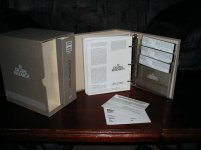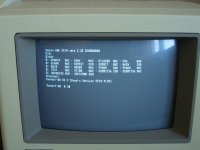xmechanic
Member
Heya folks,
I have a working '84 model Xerox 820-II and although I have a basic install of CP/M (thanks to Bill D.), I have no communications capabilities other than through a host terminal transfer, which works ok for text transfers when saved to disc, but binaries end up corrupted to hell and back, so no .HEX files or otherwise. I have the complete boxed CP/M Plus software package with both manuals and all 5 original disks (5 1/4") for a Tandy TRS-80 Model 4. I would be willing to trade this for Kermit and whatever other handy utilities you can cram onto 2 or 3 - 8" floppies already compiled for the 820-II. My machine has a working 10mb. rigid disc so once I get things loaded onto it, I'm good to go. It's just getting the stuff on there in the first place. I have a ton of CP/M software in archive, including the entire Walnut Creek CP/M CD archive, but can't get to any of it without some sort of comm program. Any help would be appreciated! Package shown below. You can contact me in this thread, or P.M. me, if interested. Thanks!
You can contact me in this thread, or P.M. me, if interested. Thanks!
Dave Land

I have a working '84 model Xerox 820-II and although I have a basic install of CP/M (thanks to Bill D.), I have no communications capabilities other than through a host terminal transfer, which works ok for text transfers when saved to disc, but binaries end up corrupted to hell and back, so no .HEX files or otherwise. I have the complete boxed CP/M Plus software package with both manuals and all 5 original disks (5 1/4") for a Tandy TRS-80 Model 4. I would be willing to trade this for Kermit and whatever other handy utilities you can cram onto 2 or 3 - 8" floppies already compiled for the 820-II. My machine has a working 10mb. rigid disc so once I get things loaded onto it, I'm good to go. It's just getting the stuff on there in the first place. I have a ton of CP/M software in archive, including the entire Walnut Creek CP/M CD archive, but can't get to any of it without some sort of comm program. Any help would be appreciated! Package shown below.
Dave Land

Last edited:

